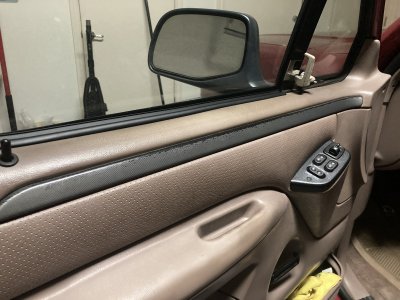(Around Seattle I'd expect to see a lower % of darker window tinted vehicles than here.)
No, its not about the over spray.
If you're considering painting in place I'd be a lot more concerned about getting dark paint on any of the light-colored interior.
The reason I asked about the window tint is that, especially with clear glass, a good amount of UV gets through, and if uncovered, the doors, seats and some other parts of the interior will continue to fade. That's even if you use a windshield sun screen-which DOES protect the dash and close in area fairly well. But while sitting next to a side car window your face/neck/arm gets exposed to UV-if the window is open OR closed.
Since I started driving (many moons ago) every vehicle I've owned (with one exception) has had either zero side window tinting or an extremely light tint. For the last 20 years I've driven almost exclusively with a/c or heater on and windows closed, and always wear a wide brimmed hat when working outside. Yet in the last several years a dermatologist has frozen and also cut off a few spots of skin cancer-all on the left side of my face.
My B2 (the exception) has DARK tinting side and back.
Though I don't put a lot of miles on it anymore, I'm getting my daily driver-an '89 Vic, tinted.
Here's an excerpt from skincancer.org
Here’s How It Works
Two main types of ultraviolet (UV) rays from the sun can cause DNA damage in your skin, even from brief exposures. The shorter UVB rays are the ones that cause sunburn, while the longer UVA rays cause tanning as well as skin aging and wrinkles. Over time, the damage from either or both types of rays can lead to skin cancer.
While glass blocks UVB rays pretty well, it doesn’t block UVA rays. Windshields are treated to shield drivers from some UVA, but side, back and sunroof windows usually aren’t. So when you’re in your car, you should protect yourself and your family from that sunlight shining through the glass.

